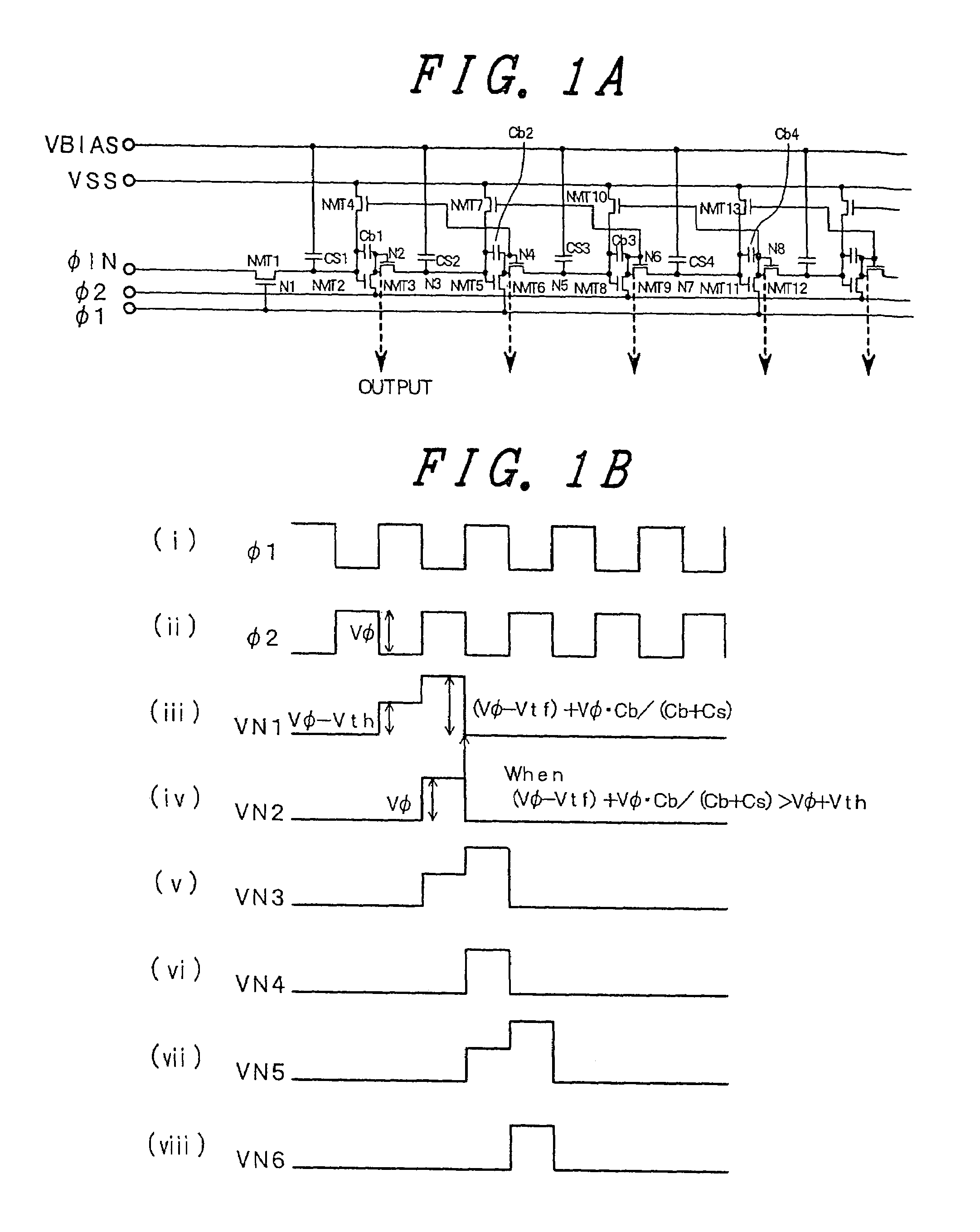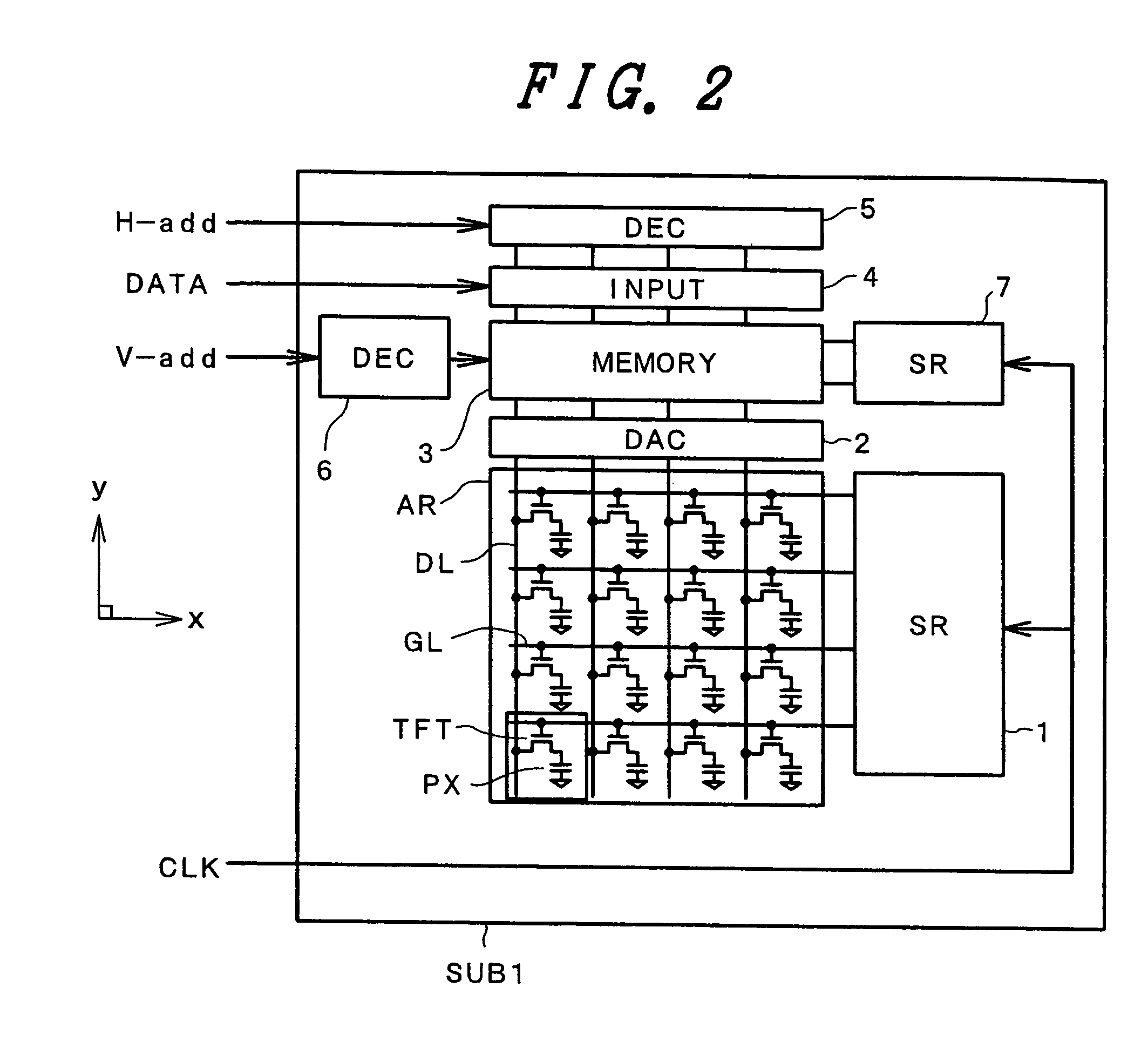Active matrix display device
a display device and active matrix technology, applied in the field of display devices, can solve the problems of inability to achieve the above-mentioned operation, unstable capacitance, and unstable dynamic ratio register operation, and achieve stable dynamic ratioless shift registers and design tolerance in states
- Summary
- Abstract
- Description
- Claims
- Application Information
AI Technical Summary
Benefits of technology
Problems solved by technology
Method used
Image
Examples
embodiment 2
[0106]FIG. 6A is a circuit diagram which shows another embodiment of a shift register formed in a liquid crystal display device according to the present invention. This embodiment is constituted differently from the embodiment 1 in which the OFF level is held by adding the load capacitance. That is, this embodiment is constituted such that a circuit is added which changes an input gate of a shift register which is not selected to “L”. That is, as shown in FIG. 6A, first of all, aMOS transistor NMT1 has the first terminal and a gate terminal thereof connected to an input terminal of an input pulse φIN thus forming an inputting part.
[0107]The MOS transistor NMT1 has the second terminal thereof connected to a gate terminal of a MOS transistor NMT4 and the first terminal of a MOS transistor NMT2. Further, the second terminal of the MOS transistor NMT1 is connected to the first terminal of a capacitance element CB1. The second terminal of a capacitance element CB2 is connected to the sec...
embodiment 3
[0129]FIG. 7A is a circuit diagram which shows another embodiment of the shift register formed on the liquid crystal display device of the present invention.
[0130]In the drawing, a circuit is constituted such that thin film transistors NNTR1, NMTR2, NNTR3, . . . which are subjected to the diode connection using respective nodes N11, N14, N17, as sources thereof and the input pulse signal φIN as drains and gates thereof are connected to the circuit exemplified in the embodiment 2.
[0131]These respective thin film transistors NMTR1, NNTR2, NMTR3, . . . reinforce the “H” level of respective nodes in the floating state when the input pulse signal φIN becomes the “H” state, thus making the forced OFF state of the non-selected input gate more reliable.
[0132]Further, an advantageous effect is obtained in that, at the start of scanning immediately after the supply of electricity, an initialization equal to that of the normal operating state can be performed.
[0133]Although the thin film trans...
embodiment 4
[0135]FIG. 11 is a circuit diagram showing another embodiment of a ratioless-type dynamic shift register which is used in the display device of the present invention. That is, this embodiment shows a further improvement of the dynamic shift registers shown in the above-mentioned respective embodiments. Further, FIG. 12 shows an input pulse timing chart of the circuit shown in FIG. 11.
[0136]Here, to clarify the characterizing portion of the ratioless-type dynamic shift register which is used in the display device of the present invention, a circuit diagram which is used for comparison is shown in FIG. 13. Further, FIG. 14 shows an input pulse timing chart of the circuit shown in FIG. 13.
[0137]In such a circuit, a jumping of the H1 clock is observed at a VSS (GND) level of a node 3 in FIG. 13. FIG. 15A illustrates this phenomenon, wherein an H1 clock after an input signal Hin appears at the VSS (GND) level (lower side of the drawing) of the node 3.
[0138]Due to a pulse which enters a n...
PUM
| Property | Measurement | Unit |
|---|---|---|
| voltage | aaaaa | aaaaa |
| fixed voltage | aaaaa | aaaaa |
| electric field | aaaaa | aaaaa |
Abstract
Description
Claims
Application Information
 Login to View More
Login to View More - R&D
- Intellectual Property
- Life Sciences
- Materials
- Tech Scout
- Unparalleled Data Quality
- Higher Quality Content
- 60% Fewer Hallucinations
Browse by: Latest US Patents, China's latest patents, Technical Efficacy Thesaurus, Application Domain, Technology Topic, Popular Technical Reports.
© 2025 PatSnap. All rights reserved.Legal|Privacy policy|Modern Slavery Act Transparency Statement|Sitemap|About US| Contact US: help@patsnap.com



